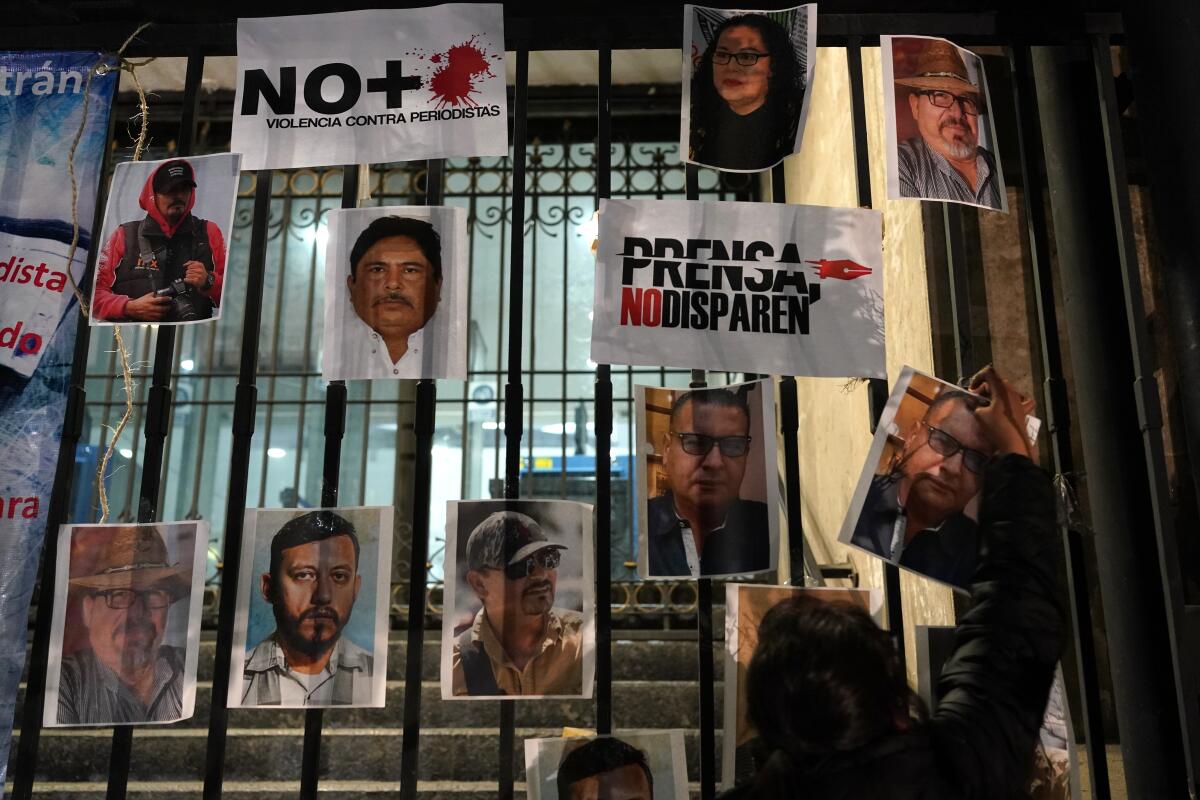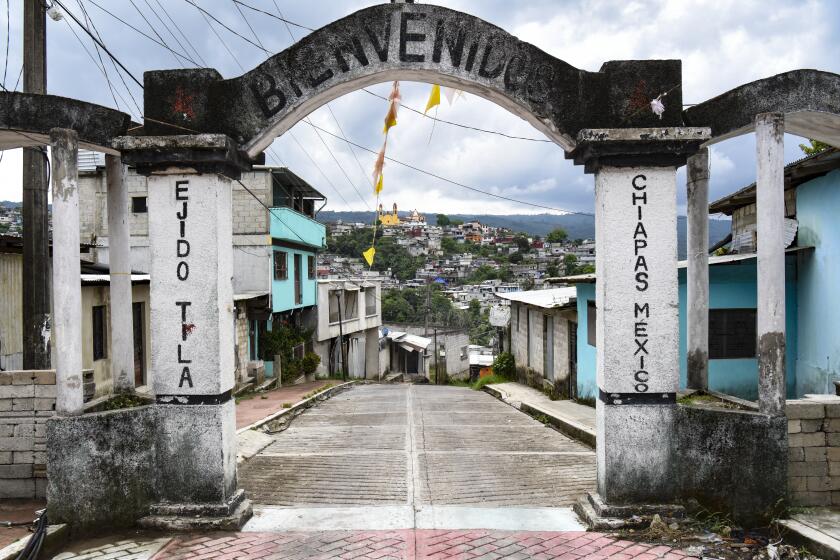Mexican journalists are dying. A new documentary tells the story

- Share via
MEXICO CITY — A Mexican journalist exiled in Southern California receives a threatening message from an organized-crime boss. A reporter investigating clandestine timber-harvesting in a Mexican forest encounters a masked logger brandishing a chain saw. A newsman in the cartel-dominated city of Culiacán laments that Mexican journalists have bull’s-eyes on their chests.
These are some moments from the documentary “Estado de Silencio” — “State of Silence” — which debuted Thursday on Netflix in the United States and Latin America.
The movie examines the experiences of four Mexican journalists to illustrate the parlous state of the press in Mexico, where at least 165 journalists have been killed or gone missing since 1992. That makes Mexico one of the most dangerous places for journalists, apart from active war zones such as the Gaza Strip.
Financing the project was La Corriente del Golfo, a production shingle founded by two of Mexico’s best-known film stars, Diego Luna and Gael García Bernal.
“We made this documentary to thank the community of journalists ... for being indispensable in our lives,” executive producer Luna told an audience at a screening this week in Mexico City.
The Times spoke with the director, Santiago Maza. The conversation has been edited for clarity.

Why a film about journalists?
Journalists are fundamental in allowing Mexico and other countries to have functional, well-informed societies. In recent years, some in power have tried to discredit the image of the journalist. This documentary seeks to remind everyone of the great work that each journalist does, even as many face great peril.
The original concept was a series about individual journalists?
Yes. Diego loved the idea, but we couldn’t secure the financing. Then the pandemic came, and in 2022 we decided to convert the project into a feature and I took over the directing reins.
Tell us about the four protagonists: Juan de Dios García Davish and María de Jesús Peters, a husband-and-wife team reporting in the southern state of Chiapas; Marcos Vizcarra, based in Sinaloa state, home turf of Mexico’s largest cartel; and Jesús Medina, who operates out of Mexico City.
These four represent a grand ensemble of voices who can speak of violence that is systemic: They allowed us to create a portrait of something that affects hundreds and thousands of journalists in Mexico.

An escalating turf war engulfing much of Mexico’s heavily Indigenous Chiapas state has displaced thousands as gangs battle for drug- and gun-trafficking routes.
What are their areas of specialty?
Jesús examines environmental exploitation and the manipulation of resources on a national level. María de Jesús and Juan de Dios report on the violence that migrants suffer along the southern border with Guatemala. And Marcos Vizcarra accompanies families of the “disappeared” and the victims of organized crime violence in Sinaloa.
How difficult was it to mesh together the backstories of these four very distinct storytellers?
This was one of our great challenges. Each person’s story is very powerful, very complex. And there are moments when the tension grows, and they have to leave their homes, hide, reinvent themselves. It took a year to edit the material. But, at the end, it was worth it: We feel that, yes, one feels a unified emotional journey.

In one scene, Juan de Dios sits in an empty coffee shop in Riverside — to where he, his wife and teenage daughter have fled — and replays a recorded phone call with a self-proclaimed “commander” of the Zetas cartel who vowed to dispatch thugs to snatch his family. Meanwhile, his wife learns that her mother back in Mexico is gravely ill. It seems you sought to portray both the professional and personal sides of your subjects?
More than 140 people have been killed in the last month in Culiacán as two factions of the Sinaloa compete to fill a power vacuum.
Mari and Juan were living a very tense moment at a family level. They didn’t want to leave the United States and return to Chiapas because they still faced danger. But they also had a personal situation that put pressure on them to return home. It became an element in the film because it showed that the violence continued, and it was necessary to show it.
Were there moments of danger for you and the crew?
The filming had its risks. We followed a security protocol. We were also very careful with the information because we had sensitive material. But we never had an incident. The best security was sticking with the journalists and local teams that helped us.
How did you manage to film Medina’s interview with an illegal logger in the pine forest in Morelos state?
We had to leave and return on several occasions, because the loggers didn’t want us there. But we explained what we wanted to do so that they would give us permission to film Jesús doing his work in the woods.
Mexico has instituted a mechanism to protect at-risk journalists and human rights defenders, providing police protection and other measures. But it falls way short, no?
I think what is lacking is a much more humanistic approach, plus a recognition on all levels of government that this crisis of violence exists, that the numbers are real. Journalists will keep doing their day-to-day work, but they need to know that the government, and the public, has their back.
Of course the challenges facing journalists in “State of Silence” go way beyond Mexico.
This is a situation that, sadly, is not limited to Mexico. For many people in power, it is not convenient to have a critical, independent press, a press that can make people feel uncomfortable, apart from their political ideology. Leaders from Trump to Putin have tried to diminish the role of journalism. It is a subversive treatment, and it has had an effect on society worldwide. I believe that now, more than ever, we should all be conscious of the fact that the value of the journalist is essential.
More to Read
Sign up for Essential California
The most important California stories and recommendations in your inbox every morning.
You may occasionally receive promotional content from the Los Angeles Times.












